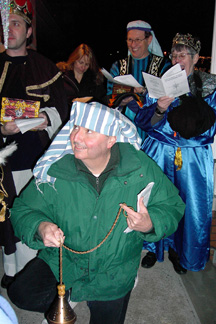|
|
|
|
Please patronize our sponsors. Ads with links are clickable. Hasbrouck Heights In Western churches, it remembers the coming of the Wise Men bringing gifts to visit the Christ child, and by so doing, "reveal" Jesus to the world as Lord and King. An Ecumenical Procession was held Friday, January 6, 2006, from 6:00 to 7:30 p.m. The public was invited to attend and many joined the procession at any church. Participants followed the path of the star and followed the angels’ herald. Selected players werecostumed. At each church sanctuary there was a tableau to recount the Journey of the Magi, and include a brief reciting of liturgy. The walk began at 6:00 p.m. at the First United Methodist Church, proceeded to many of the community churches and ended at Holy Trinity Lutheran Church. The star was lit and there was the "Gathering of The Shepherds" as the procession began. At each stop along the way, "we" were invited into each church’s sanctuary and called forth one of the participants in the Epiphany story tableau. There was a calling of the First Magi, Caspar, with the gift of gold, a calling of the Second Magi, Melchior, with the gift of frankincense and a calling of the Third Magi, Balthasar, with the gift of Myrrh. "La Befana" visited and told her story (an Italian tradition and legend) at the end of the journey. Holy Trinity has also conducted an evening Epiphany Worship Service at 7:30 p.m. Photos by Karen Fels ###
##### About "Epiphany" In the Church’s celebration, it is a reminder of the visit to the Christ Child by the Magi, the Wise Men. It is also a symbol of Christ’s manifestation to the "Gentiles", the "other-than-Hebrews", and not for one group of people only. Christ is therefore seen as the "Light of the World" (John 8:12). Consequently, the celebration of The Epiphany is often called the Christian "Festival of Lights." In many European countries, especially France, Portugal and Spain, children place their shoes, filled with oats on the doorsteps of their houses on the eve of Epiphany. This is done to feed the animals (traditionally camels, horses and elephants) of the Magi while they are "en route to Bethlehem." The next day, children awake to find that the Wise Men have left gifts in the shoes. This tradition has also found its way to many Latin American traditions where children leave their shoes at the foot of their beds in anticipation of gifts left for them by the benevolent Wise Men. The Season of Epiphany includes the time between The Epiphany, (January 6th), and the coming of Ash Wednesday (March 5th), which begins the Lenten Season. The Season after Epiphany (sometimes called "Ordinary Time") signifies Christ’s public ministry and his working in our souls for all the world’s care. The Church colors for celebration of Epiphany include both white and green. The white is used for The Epiphany (January 6th). White marks our major festivals as a symbol and reminder of the purity of the Lord, and of our participation in his forgiveness. Green is the Church’s color for "life and growth." The Season of Epiphany is green because it represents the growth of the Church in all the world, as the Magi take what they have learned of the Christ Child’s birth back to their homes and native lands. The seeds are sown for the
Church’s growth throughout the world. ### About "La Befana" Legend has it that the three Wise Men were in search of the Christ child and stopped at a small house. An old woman holding a broom opened the door and at her doorstep, were three colorfully dressed men who sought directions for the Christ child. The old woman did not know who these men were looking for and could not help them. They asked the woman to join them on their journey. She declined because she had too much housework. Later she decided to go and catch up with them, but she could not find them. Thinking of the opportunity she had missed the old woman stopped every child to give them a small treat in hopes that one was the Christ child. On the eve of the Epiphany, each year she sets out looking for the baby Jesus and stops by at each child’s home to leave treats in their stocking for those who were good -- a lump of coal for those who were bad. Buona Festa!
Thank
you for visiting our hometown. Come back soon!
|















